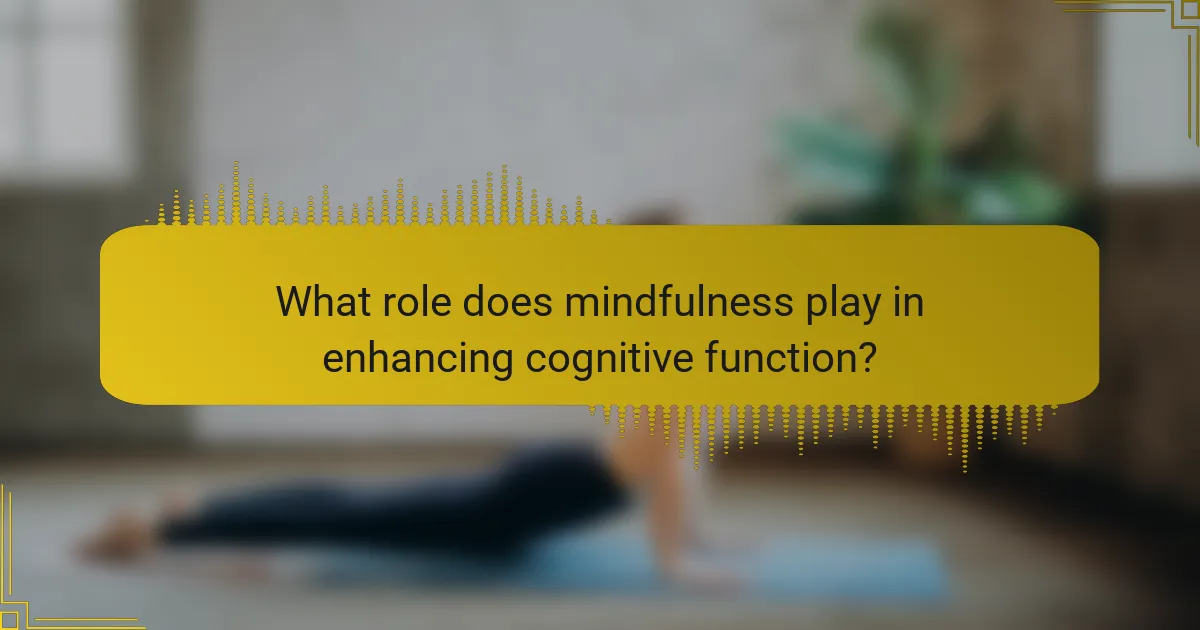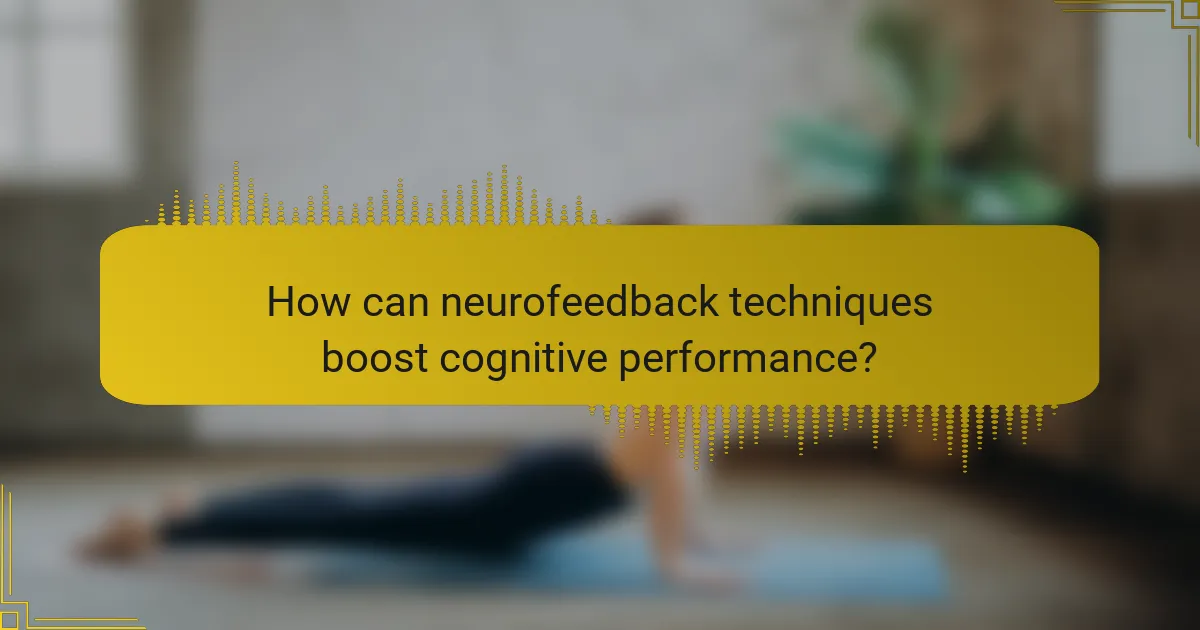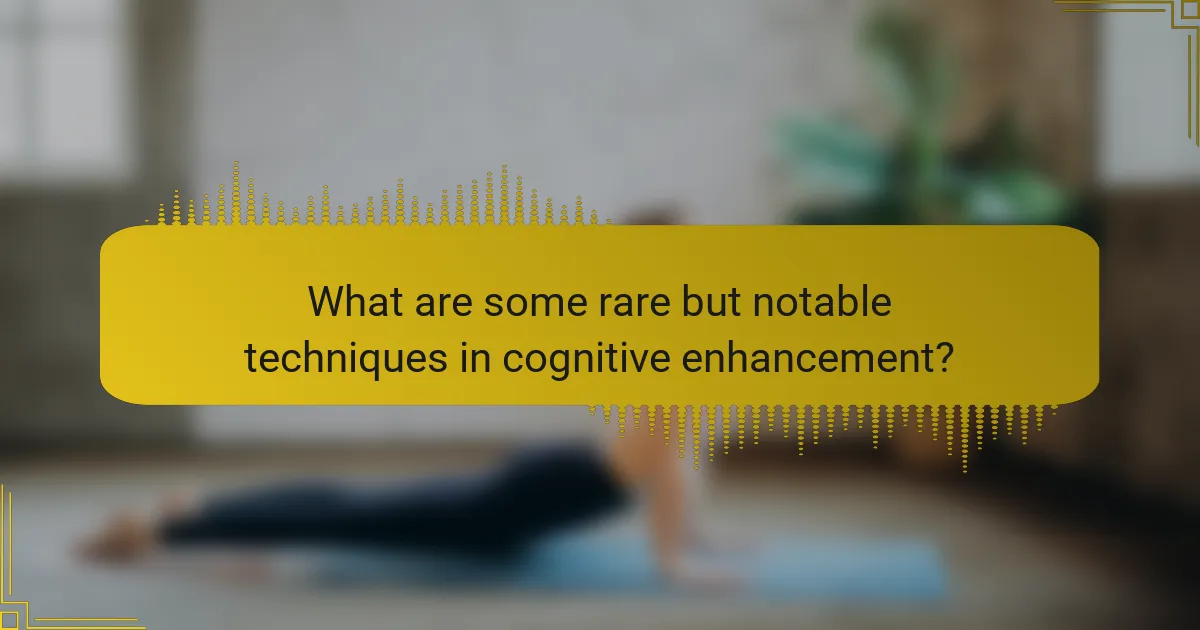Enhancing cognitive function is crucial for managing daily challenges and improving overall mental performance. Mindfulness techniques improve focus and emotional regulation, while neurofeedback trains brain activity for better attention. Breathwork promotes relaxation and reduces stress, further supporting cognitive clarity. Together, these practices foster neuroplasticity and lead to measurable improvements in memory retention and cognitive flexibility.

What role does mindfulness play in enhancing cognitive function?
Mindfulness significantly enhances cognitive function by improving focus, memory, and emotional regulation. Research indicates that regular mindfulness practice can lead to structural brain changes, particularly in areas associated with attention and memory retention. Mindfulness techniques, such as meditation, promote neuroplasticity, allowing the brain to adapt and grow. Additionally, these practices reduce stress, which can negatively impact cognitive performance. As a result, individuals who engage in mindfulness are often better equipped to handle complex tasks and maintain mental clarity.
How does mindfulness meditation improve focus and attention?
Mindfulness meditation significantly enhances focus and attention by training the brain to maintain awareness on the present moment. This practice reduces distractions and improves cognitive control. Studies show that regular mindfulness meditation can lead to structural changes in the brain, particularly in areas associated with attention and emotional regulation. As a result, practitioners often experience heightened concentration and improved task performance.
What are the long-term cognitive benefits of regular mindfulness practice?
Regular mindfulness practice enhances cognitive function by improving focus, memory, and emotional regulation. Long-term benefits include increased gray matter density in brain regions associated with learning and memory, such as the hippocampus. Studies show that practitioners experience reduced anxiety and improved attention span, leading to better decision-making. Mindfulness also fosters neuroplasticity, allowing the brain to adapt and grow through continuous learning.

How can neurofeedback techniques boost cognitive performance?
Neurofeedback techniques can significantly enhance cognitive performance by training the brain to optimize its activity. These techniques improve focus, memory, and emotional regulation through real-time feedback on brainwave patterns. Research shows that consistent neurofeedback training can lead to measurable increases in attention span and cognitive flexibility. Additionally, neurofeedback can help reduce anxiety, which often hampers cognitive function. As a result, individuals experience heightened mental clarity and improved problem-solving abilities, making neurofeedback a valuable tool for cognitive enhancement.
What is the science behind neurofeedback and brainwave training?
Neurofeedback and brainwave training enhance cognitive function by teaching individuals to modulate their brain activity. This technique utilizes real-time displays of brain activity to promote self-regulation of brainwave patterns, particularly enhancing alpha and beta waves associated with focus and relaxation. Studies show neurofeedback can lead to improved attention, memory, and emotional regulation. By integrating mindfulness practices with neurofeedback, individuals can further amplify these cognitive benefits, creating a synergistic effect that enhances overall mental performance.
What are the different types of neurofeedback protocols?
Neurofeedback protocols vary widely, primarily categorized into types such as EEG biofeedback, HEG neurofeedback, and neurofeedback using fMRI. Each type targets different brain functions and cognitive enhancements. EEG biofeedback focuses on electrical activity, while HEG neurofeedback measures blood flow, and fMRI neurofeedback visualizes brain activity in real-time. These protocols are tailored to specific cognitive functions, such as attention, memory, and emotional regulation.
How effective is neurofeedback for improving memory and learning?
Neurofeedback significantly enhances memory and learning by training brain activity. Studies indicate improvements in working memory and cognitive flexibility through targeted neurofeedback protocols. For instance, a meta-analysis found an average effect size of 0.73 for cognitive enhancement in participants using neurofeedback. This technique promotes self-regulation of brain function, leading to better focus and retention of information. As a result, individuals often experience improved academic performance and overall cognitive resilience.

What impact do breathwork techniques have on mental clarity?
Breathwork techniques significantly enhance mental clarity by promoting relaxation and reducing stress. These practices improve oxygen flow to the brain, which enhances cognitive function and focus. Research indicates that deep breathing can lower cortisol levels, resulting in improved concentration and decision-making abilities. Regular practice can lead to sustained mental clarity and better emotional regulation.
How can specific breathwork practices enhance cognitive function?
Specific breathwork practices can significantly enhance cognitive function by improving focus, reducing stress, and increasing mental clarity. Techniques such as diaphragmatic breathing and box breathing have been shown to activate the parasympathetic nervous system, leading to better oxygenation and blood flow to the brain. Research indicates that these practices can increase attention span and memory retention, making them valuable tools for cognitive enhancement. Additionally, regular breathwork can promote emotional regulation, further supporting cognitive performance in high-pressure situations.
What are the physiological mechanisms behind breathwork and cognition?
Breathwork enhances cognitive function through physiological mechanisms like increased oxygen flow and reduced stress. These processes improve brain activity, enhance focus, and promote emotional regulation. For example, deep breathing stimulates the vagus nerve, leading to a calming effect on the mind, which can enhance cognitive clarity. Additionally, breathwork can increase neuroplasticity, allowing the brain to adapt and learn more effectively. As a result, incorporating breathwork into mindfulness practices can significantly boost overall cognitive performance.
What are the unique combinations of mindfulness, neurofeedback, and breathwork?
Mindfulness, neurofeedback, and breathwork create unique combinations that enhance cognitive function. These techniques synergistically improve focus, emotional regulation, and stress reduction. Mindfulness fosters present-moment awareness, neurofeedback provides real-time brain activity feedback, and breathwork regulates physiological responses. Together, they promote optimal mental performance and resilience against cognitive decline.

What are the universal benefits of integrating these practices?
Integrating mindfulness, neurofeedback, and breathwork techniques enhances cognitive function by improving focus, reducing stress, and promoting emotional regulation. These practices foster neuroplasticity, enabling the brain to adapt and grow stronger. Research indicates that regular engagement can lead to measurable improvements in attention span and memory retention. As a result, individuals experience heightened mental clarity and overall cognitive performance.
How do these techniques collectively support mental health?
Mindfulness, neurofeedback, and breathwork techniques collectively enhance mental health by promoting emotional regulation, reducing stress, and improving cognitive clarity. Mindfulness fosters present-moment awareness, which decreases anxiety and enhances mood stability. Neurofeedback trains brain activity, leading to improved focus and emotional resilience. Breathwork techniques regulate the nervous system, reducing physiological stress responses. Together, these practices create a holistic approach to mental well-being, supporting individuals in managing their emotions and enhancing cognitive function effectively.
What are the common challenges faced when adopting these practices?
Adopting mindfulness, neurofeedback, and breathwork techniques often presents challenges such as resistance to change, difficulty in maintaining consistency, and the need for proper training. Resistance arises from ingrained habits and skepticism about new practices. Consistency is crucial for effectiveness, yet many struggle to integrate these techniques into daily routines. Additionally, accessing qualified instructors or resources can be a barrier, limiting the ability to fully benefit from these practices.

What are some rare but notable techniques in cognitive enhancement?
Mindfulness, neurofeedback, and breathwork techniques offer rare cognitive enhancement methods. Mindfulness enhances attention and emotional regulation, while neurofeedback trains brain activity for improved focus. Breathwork techniques, such as cyclic sighing, can reduce stress and improve cognitive flexibility. Each technique provides unique benefits that can contribute to overall cognitive function.
How can technology augment mindfulness and breathwork practices?
Technology can significantly enhance mindfulness and breathwork practices by providing real-time feedback and personalized experiences. Tools like mobile apps and wearable devices offer guided sessions, track progress, and analyze physiological responses, promoting deeper engagement. For instance, neurofeedback devices can help users visualize their brain activity, enabling them to adjust their mindfulness techniques effectively. Additionally, virtual reality can immerse users in calming environments, enhancing relaxation and focus during breathwork exercises. These technological advancements cater to unique user needs, making mindfulness more accessible and effective.
What emerging research is shaping the future of cognitive bio-hacking?
Emerging research is increasingly highlighting the benefits of mindfulness, neurofeedback, and breathwork techniques in enhancing cognitive function. Studies suggest that mindfulness practices improve attention and working memory, while neurofeedback can optimize brain activity patterns. Breathwork techniques are shown to reduce stress and enhance mental clarity. These approaches collectively contribute to a holistic strategy for cognitive bio-hacking, shaping future interventions in mental performance enhancement.

What practical steps can you take to implement these techniques?
To implement mindfulness, neurofeedback, and breathwork techniques, start with daily practice. Schedule specific times for mindfulness meditation, aiming for at least 10 minutes each session. Incorporate neurofeedback sessions using a certified device, focusing on brainwave patterns for improvement. Lastly, practice breathwork techniques, such as diaphragmatic breathing, for stress reduction and increased focus. Regularly track your progress to identify benefits and adjust your routine as needed.
What are the best practices for starting a mindfulness routine?
To start a mindfulness routine effectively, focus on consistency, simplicity, and gradual progression. Begin with short sessions, around 5-10 minutes daily, and gradually increase duration. Choose a quiet space to minimize distractions and use guided meditations or mindfulness apps for structure. Incorporate breathwork techniques to enhance focus and cognitive function. Track your progress to stay motivated and adjust practices to suit your needs. Engaging in mindfulness consistently can lead to improved mental clarity and emotional regulation.
How can you effectively incorporate neurofeedback into your lifestyle?
To effectively incorporate neurofeedback into your lifestyle, start by setting clear cognitive goals. Engage in regular sessions with a trained professional or utilize home-based neurofeedback devices. Track your progress to ensure improvements in focus and emotional regulation. Consider integrating mindfulness practices and breathwork techniques to enhance the overall benefits of neurofeedback. Consistency in practice is essential for long-term cognitive enhancement.
What common mistakes should be avoided when practicing breathwork?
To enhance breathwork practice, avoid common mistakes such as improper posture, shallow breathing, and lack of focus. These errors can hinder cognitive benefits and overall effectiveness. Ensuring a comfortable position promotes deeper breaths, while maintaining concentration maximizes mindfulness benefits. Additionally, neglecting gradual progression may lead to discomfort or overwhelm.
What expert insights can guide your cognitive enhancement journey?
Mindfulness, neurofeedback, and breathwork significantly enhance cognitive function. These techniques improve focus, reduce stress, and enhance mental clarity. Mindfulness fosters present-moment awareness, neurofeedback trains brain activity, and breathwork regulates the nervous system. Implementing these practices leads to measurable cognitive benefits, such as improved memory and decision-making skills. Regular application ensures sustained enhancements over time.